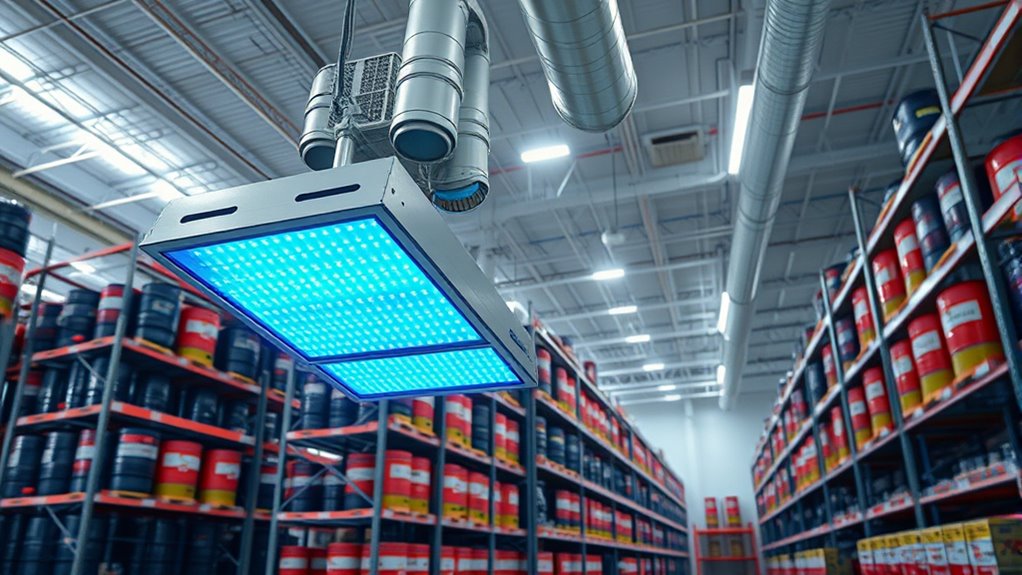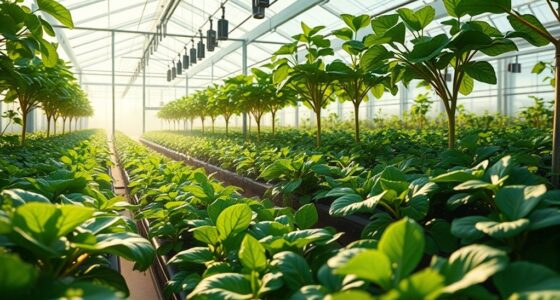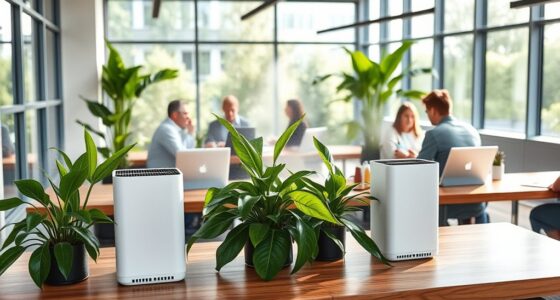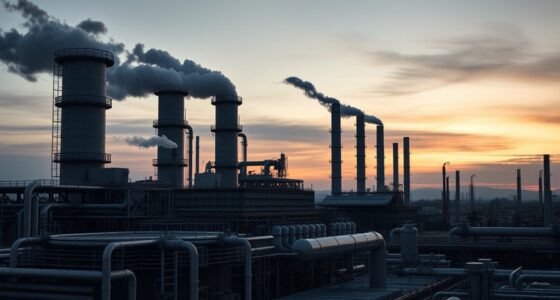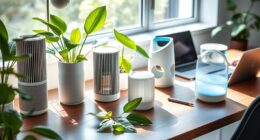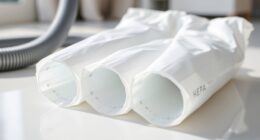To guarantee safe air quality in warehouses handling hazardous chemicals, you should use a combination of air purifiers with activated carbon filters and particulate filters. Regular maintenance of these filters is crucial to keep VOC levels and airborne pollutants low, preventing chemical vapors from accumulating. Strategic placement and ongoing vigilance help maximize system efficiency and compliance. Keep exploring to discover how proper filtration strategies can protect your staff and meet safety standards effectively.
Key Takeaways
- Implement activated carbon filtration systems to effectively adsorb and remove hazardous chemical vapors from warehouse air.
- Regularly monitor VOC levels and perform routine filter inspections, cleaning, or replacements to maintain optimal air quality.
- Use combined filtration approaches, integrating particle filters with chemical-absorbing media for comprehensive contaminant removal.
- Strategically position air purifiers to ensure even airflow and maximize exposure to chemical vapors and particulate pollutants.
- Educate staff on proper filter maintenance and VOC management practices to sustain a safe, compliant warehouse environment.
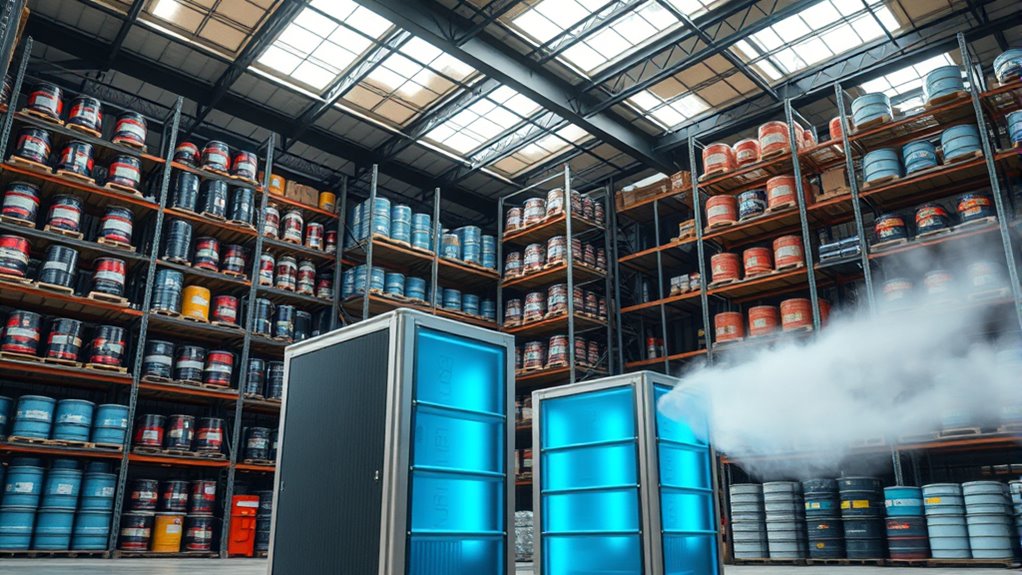
Maintaining clean air in warehouses is essential for ensuring a safe and healthy environment for employees and products alike. When handling hazardous chemicals, the quality of the air becomes even more critical, as airborne contaminants can pose serious health risks. One key aspect of effective air purification in these settings is VOC removal. Volatile organic compounds are common in warehouses that store or process chemicals, and they can easily become airborne, affecting air quality and worker health. To combat this, you need a robust air filtration system designed specifically to target VOCs. Activated carbon filters are particularly effective for this purpose, as they adsorb chemical vapors and reduce their concentration in the air. Regularly monitoring the VOC levels helps you determine when your filtration system needs to be upgraded or intensified, ensuring continuous protection.
Equally important is filter maintenance. Even the best air filtration systems can become ineffective if filters aren’t properly maintained. Over time, filters trap dust, chemical particles, and other pollutants, which can clog them and reduce airflow. This not only diminishes the filter’s ability to remove VOCs but also puts extra strain on the entire ventilation system. You should establish a routine schedule for inspecting, cleaning, or replacing filters based on the manufacturer’s recommendations and the specific chemical load in your warehouse. Neglecting filter maintenance can lead to increased emissions of hazardous substances into the workspace, jeopardizing employee health and compromising product integrity. Proper filter upkeep also prolongs the lifespan of your HVAC system, saving money in the long run and ensuring consistent air quality.
Additionally, integrating VOC removal strategies with overall air filtration enhances safety. Use air purifiers equipped with activated carbon or other chemical-absorbing media alongside particulate filters. This dual approach ensures you’re targeting both airborne particles and chemical vapors effectively. Proper placement of these units around the warehouse optimizes airflow and maximizes purification efficiency. Educate your staff on the importance of filter maintenance and VOC management, so everyone understands how their actions impact air quality. Regular training and routine checks help catch potential issues early, preventing air quality deterioration. Remember, maintaining a clean, safe environment isn’t just about installing the right equipment—it’s about commitment and ongoing vigilance. By prioritizing VOC removal and diligent filter maintenance, you protect your team, safeguard your products, and ensure compliance with health and safety regulations. Incorporating high-quality home theatre projectors with advanced filtering systems can also improve overall indoor air quality by reducing the emission of chemical fumes from electronic components and manufacturing processes.
Frequently Asked Questions
How Often Should Air Purifiers Be Maintained in Hazardous Chemical Warehouses?
You should perform maintenance on your air purifiers every 3 to 6 months, depending on usage and chemical exposure levels. Regular maintenance includes inspecting and replacing filters to guarantee peak performance. In hazardous chemical warehouses, more frequent filter replacements might be necessary if you notice reduced airflow or odors. Consistently following the recommended maintenance frequency helps keep the air clean and safe for workers, preventing chemical buildup and contamination.
Are There Specific Certifications for Air Purification Systems Used in Chemical Storage?
Think of certifications as the gold standard for chemical safety; yes, there are specific ones you should look for. These include standards like UL 867, HEPA filtration standards, and NSF certification, which guarantee your air purification systems meet strict filtration standards. Such certifications act as a shield, assuring your system effectively removes hazardous particles and maintains a safe environment, so you can confidently protect your warehouse and staff from airborne dangers.
What Are the Costs Associated With Upgrading to Advanced Air Purification Systems?
Upgrading to advanced air purification systems involves a significant equipment investment, with costs varying based on system size and complexity. You should conduct a thorough cost analysis to understand initial expenses and ongoing maintenance. While the upfront costs may be high, the improved safety and compliance benefits can justify the investment, reducing long-term risks and operational disruptions. Planning ahead guarantees you allocate sufficient budget for both purchase and future system upgrades.
How Do Temperature and Humidity Affect Air Purifier Effectiveness in Chemical Warehouses?
If you ignore humidity control and temperature regulation, your air purifier’s effectiveness can plummet! Excess humidity can cause mold and reduce filtration efficiency, while extreme temperatures can damage equipment or hinder air flow. Maintaining ideal humidity and temperature levels ensures your air purification system works at its peak, effectively removing hazardous chemicals and protecting your warehouse environment. Don’t let environmental fluctuations sabotage your air quality—manage them proactively!
Can Portable Air Purifiers Adequately Protect Large Warehouse Environments?
Portable air purifiers can help improve air quality in large warehouses, but they might not be enough alone. Fixed systems with higher capacity are more effective for extensive spaces handling hazardous chemicals. Portable units are convenient and cost-effective for smaller zones, but for full coverage, you need a system designed for the warehouse’s size and air purifier capacity. Combining both can offer better protection and guarantee cleaner, safer air.
Conclusion
Just as Prometheus brought fire to humanity, your commitment to air purification fuels a safer warehouse environment. By choosing effective filtration systems, you guarantee hazardous fumes are kept at bay, protecting both workers and your valuable inventory. Remember, strong air quality isn’t just a modern necessity—it’s a guardian, much like the mythic shield of Athena. Keep your warehouse a fortress of safety, and breathe easy knowing you’ve taken the right steps toward a healthier, hazard-free space.
